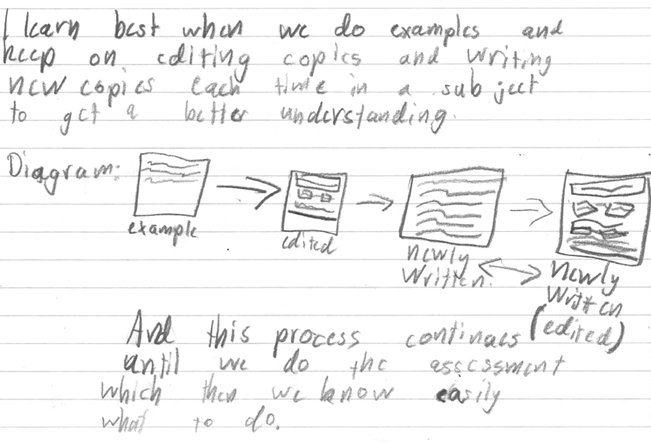Brisbane Central State School follows a student-centred model of feedback for learning. Students are involved in:
- Giving and receiving feedback on their learning;
- Asking for feedback; and
- Knowing how to use feedback to improve their learning/work.
Students engage in learning experiences to understand what a quality piece of work looks like, where their work is in comparison to this and what their next step is. Through this the students get clarity about what they can do to improve. This year we continue to embed our feedback practices in the classroom to give our students the best chance of continued learning improvement now and in the future as they learn to be reflective, self-motivated learners and they learn the strategies to employ to improve their work.

Feedback at the initial phase of the learning
At the start of a period of learning on a particular focus, students are engaged in experiences to gain a clear understanding of what a quality piece of work looks like. This process is called co-constructing success criteria. Students are guided through a process of analysing samples of work to determine the features that make it successful. By developing this clear understanding of what quality looks, students better understand what they are aiming for and can give and act on feedback purposefully to move their learning forward.
In addition, during this early phase of the learning, the students engage in an activity that shows what they know and can do. The samples of student work are used by the teachers to design the learning going forward. This process is called formative assessment and is vital to targeting the teaching to student learning needs.
Feedback during the learning
Teachers continue to use the student’s demonstrated ability in samples of work to inform what is important in the teaching and as feedback on how effective the teaching has been. In this way teachers revise what they are teaching and how they are teaching to best target the student learning needs. Students learn how to and are provided multiple opportunities to give, receive and use feedback to improve their own learning. Students use the feedback resources in the classroom to know what quality looks like and to improve their own work, with growing independence. The feedback learning resources are prominently displayed on the Improvement Wall, including the learning intention, success criteria, samples of work, and models of how to improve.

Feedback during assessment
Teachers actively use feedback strategies as part of the implementation of the assessment. When planning the units of learning in English, the teachers work in year level teams to plan for the use of feedback within the implementation of the assessments. Teachers discuss, agree on and record the access to feedback that will be consistently applied across the year level during the completion of the assessment.
Some types of feedback that students may be able to access while doing an assessment include:
- Feedback to self - students are guided to use resources developed and accessed during the term to find the strengths and gaps in their own assessment piece and to find how to improve
- Peer feedback – students are provided opportunities to give and receive feedback from peers on their draft assessment piece based on a clear set of criteria that the students have worked with over the term
- Teacher feedback – students are provided with feedback from the teacher on their draft assessment piece. This may be limited to whole class feedback and models of how to improve covering the main needs identified in the students’ drafts or individual feedback on areas for improvement without direct teacher directions on how to improve.
The feedback opportunities are selected and implemented by the teachers to suit the year level, nature of the assessment piece, the need to maintain the integrity of the assessment and with careful consideration of the students’ needs.